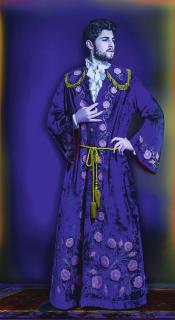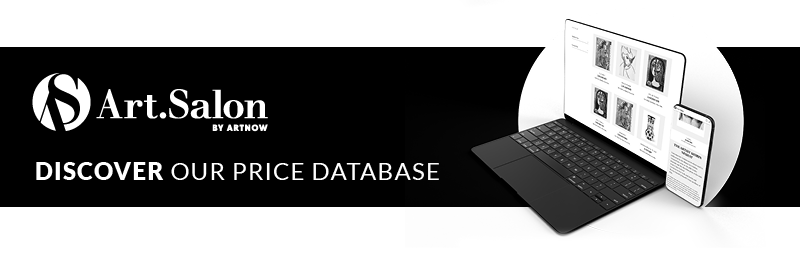Iké Udé Nigerian - American, born 1964
The artist Iké Udé
- U.S.-Nigerian photographer and performance artist.
- His Cover Girls helped him achieve his breakthrough.
- He criticizes society with his satirical artistic self-dramatizations.
Idé Udé is a U.S.-Nigerian photographer, performance artist, writer and publisher. Born in 1964, he tried his hand at fashion and photography as a child during bi-weekly family portrait appointments. Even then, the medium fascinated him. Udé grew up in Nigeria, going to a British boarding school in Afikpo during his school years. After a stint in London, he moved to New York in 1981, where he attended Hunter College, CUNY. He studied media communications there.
For a few years in the late 1980s, Udé devoted himself to abstract painting and drawing. While Udé's paintings and drawings are less well known than his photographs, these works have impressed art critics and historians in particular. His subtle and informal way of combining his New York lifestyle with his Nigerian roots is considered particularly successful.
Starting in the 1990s, Udé worked with his later preferred medium of photography. His photographic success story began with his series Cover Girls (1994). Udé staged himself in these pictures and imitated well-known magazine covers. With these authentic-looking covers, he criticized the social fetishism of white upper-class models and the effects of this pop culture on consumer society. With the series, he nevertheless pointed out the lack of representation of black people and racist stereotypes.
With his exhibition Paris Hilton: Fantasy and Simulacrum (2009), his alter ego Visconti conversed with celebrity and hotelier's daughter Paris Hilton. With the mixed-media works on display, made from gossip magazines, porn magazines, mirrors, and wallpaper samples, Udé introduced the phenomenon of Paris Hilton and raised questions about aesthetics and cultural decay.
One of his most recent series of works are the Sartorial Anarchy self-portraits. They exude haute couture by combining contemporary with historical clothing. On them, Udé constitutes costumes, props, and his pose into still lifes. He painted the backgrounds himself and digitally reworked them. The series was on view as part of the Global Africa Project at the Museum of Arts and Design (MAD) in New York (2010) and in Artist/Rebel/Dandy: Men of Fashion at the Rhode Island School of Design Museum (2013).
In 1995, he founded aRUDE magazine. The title is a tribute to the Jamaican Rude Boys in 1960s London. In it, he sometimes publishes interviews with personalities in art, photography, and design. Since 2009, aRUDE has been published digitally only. Udé still lives and works in New York.
Der Künstler Iké Udé
- US-amerikanisch-nigerianischer Fotograf und Performance-Künstler.
- Seine Cover Girls verhalfen ihm zum Durchbruch.
- Übt mit seinen satirisch-künstlerischen Selbstinszenierungen Kritik an der Gesellschaft.
Idé Udé ist ein US-amerikanisch-nigerianischer Fotograf, Performance-Künstler, Autor und Verleger. 1964 geboren erprobte er sich schon als Kind bei den zweiwöchigen Familienporträtterminen in Mode und Fotografie. Schon damals faszinierte ihn das Medium. Udé wuchs in Nigeria auf, ging während seiner Schulzeit auf ein britisches Internat in Afikpo. Nach einem Aufenthalt in London zog er 1981 nach New York, wo er das Hunter College, CUNY besuchte. Er studierte dort Medienkommunikation.
In den späten 1980er Jahren widmete sich Udé für wenige Jahre der abstrakten Malerei und Zeichnung. Zwar sind Udés Gemälde und Zeichnungen weniger bekannt als seine Fotos, doch beeindruckten diese Arbeiten vor allem Kunstkritiker und -historiker. Als besonders gelungen gilt seine subtile und ungezwungene Art, seine Lebenswelt aus New York mit seinen nigerianischen Wurzeln zu verbinden.
Ab den 1990er Jahren arbeitete Udé mit seinem später präferierten Medium der Fotografie. Auftakt seiner fotografischen Erfolgsgeschichte bildet seine Serie Cover Girls (1994). Udé inszenierte sich auf diesen Bildern selbst und ahmte bekannte Magazincover nach. Er kritisierte mit den authentisch wirkenden Covers den gesellschaftlichen Fetischismus weißer Upper-Class-Models und die Auswirkungen dieser Popkultur auf die Konsumgesellschaft. Er wies mit der Reihe gleichwohl auf die fehlende Repräsentation Schwarzer Menschen und rassistische Stereotype hin.
Mit seiner Ausstellung Paris Hilton: Fantasy and Simulacrum (2009) unterhielt sich sein Alter Ego Visconti mit Celebrity und Hotelierstochter Paris Hilton. Mit den ausgestellten Mixed-Media-Arbeiten aus Klatschzeitschriften, Pornoheften, Spiegel und Tapetenmustern führte Udé das Phänomen Paris Hilton vor Augen und stellte Fragen zu Ästhetik und des kulturellen Verfalls.
Eine seiner jüngsten Werkreihen sind die Sartorial Anarchy-Selbstportäts. Sie versprühen Haute Couture, indem sie zeitgenössische mit historischer Kleidung kombinieren. Udé konstituiert darauf Kostüme, Requisiten und seine Pose zu Stillleben. Die Hintergründe malte er selbst und bearbeitete sie digital nach. Zu sehen war die Reihe im Rahmen des Global Africa Project im Museum of Arts and Design (MAD) in New York (2010) und in Artist/Rebel/Dandy: Men of Fashion im Rhode Island School of Design Museum (2013).
1995 gründete er die Zeitschrift aRUDE. Der Titel ist eine Hommage an die jamaikanischen Rude Boys im London der 1960er Jahre. Er veröffentlicht darin mitunter Interviews mit Persönlichkeiten aus Kunst, Fotografie und Design. Seit 2009 erscheint aRUDE nur noch digital. Udé lebt und arbeitet noch heute in New York.
Iké Udé in a nutshell
Nollywood Portraits – A Radical Beauty is the title of a book by Iké Udé, published by Skira in 2017. It brings together a selection of photographic portraits by Iké Udé featuring key Nigerian actors, television presenters, directors and producers. The portraits were also on view at the Smithsonian National Museum of African Art in Washington, D.C., from February 2022 to May 2023 as part of the eponymous exhibition Iké Udé: Nollywood Portraits.
The term Nollywood originated with New York Times journalist Norimitsu Onishi. It alludes to Nigeria's prolific, three-billion-dollar film industry, which Nigerian actors, writers, producers and directors have created to tell »home-grown« stories. The industry has greatly shaped the way Nigerians and other Africans see themselves and are seen by others.
So far, there have been only a few official auctions with works by Iké Udé. One of them took place in 2018 at the auction house Sotheby's in New York City – the portrait Unique Commissioned Photograph Portrait fetched 20,000 USD. Those interested in works by Udé should not wait for an auction, but contact the artist or his gallery directly.
Häufige Fragen zu Iké Udé
Nollywood Portraits – A Radical Beauty ist der Titel eines Bildbandes von Iké Udé, das 2017 bei Skira erschienen ist. Es versammelt eine Auswahl fotografischer Porträts von Iké Udé, die wichtige nigerianische Schauspieler, Fernsehmoderatoren, Regisseure und Produzenten zeigen. Die Porträts waren von Februar 2022 bis Mai 2023 außerdem im Rahmen der gleichnamigen Ausstellung Iké Udé: Nollywood Portraits im Smithsonian National Museum of African Art in Washington, D.C. zu sehen.
Der Begriff Nollywood geht auf den New-York-Times-Journalisten Norimitsu Onishi zurück. Er spielt auf Nigerias produktive, drei Milliarden Dollar schwere Filmindustrie an, die nigerianische Schauspieler, Autoren, Produzenten und Regisseuren gegründet haben, um »einheimische« Geschichten zu erzählen. Die Industrie hat die Art und Weise, wie Nigerianer und andere Afrikaner sich selbst sehen und von anderen gesehen werden, stark mitgeprägt.
Bisher gab es nur wenige, offizielle Auktionen mit Arbeiten von Iké Udé. Eine davon fand 2018 beim Auktionshaus Sotheby's in New York statt – das Porträt Unique Commissioned Photograph Portrait erzielte 20.000 USD. Wer an Werken von Udé interessiert ist, sollte nicht auf eine Auktion warten, sondern den Künstler oder seine Galerie direkt kontaktieren.






